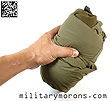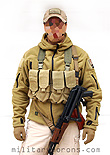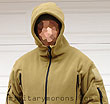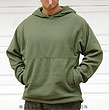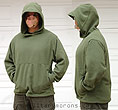Fleece/Insulated Tops Page
1 2 3
4
As a sizing reference: I'm 5'7", 155 lbs (yeah, I'm a little guy), medium build (BDU top medium/regular, BDU pant medium/short), waist 32", chest 43". Keep this in mind when you read my comments with respect to sizing, so you have an idea of how the garments featured below will fit on you. ALL garments in these pages are size Medium, unless stated otherwise.
TO VIEW FULL SIZE IMAGES: USERNAME and PASSWORD are both "mm"
| 11/7/09 - New for fall 2009 from the LEAF (Law Enforcement and Armed Forces) division of Arc'Teryx is the Atom LT Jacket. The Atom LT is a mid layer that functions as light outer wear. It's designed to be modern, warmer and more water-resistant alternative to the old M65 field jacket button-in liner, to which some manufacturers added buttons in the front so it could be worn as a stand-alone garment. It's a trim-fitting insulating jacket that can be worn as a layer under a hard shell to provide warmth, or by itself as a wind and water-resistant jacket. It is very lightweight for the warmth it provides and is highly compressible. I see it replacing a lot of mid-layers, sweatshirts and light weight fleece sweaters. Material - The Atom LT has a composite construction, utilizing different materials for the shell on the main body and side panels. The matte outer shell is made of super light Luminaria nylon weave which is thin yet durable, and treated with a DWR finish for water resistance. The smooth and silky inside liner is also made of Luminaria. The Atom LT is essentially the same jacket as that offered on the commercial side, but for LEAF, it's available in one additional colour - Crocodile (shown here), which is a khaki-ish olive and a subdued Bird logo on the left chest. The side panels are made of Polartec Power Stretch with Hardface Technology, which is a body-hugging 4-way stretch fabric with two unique surfaces - a soft fleece inner layer for warmth and comfort; and a smooth outer layer that is abrasion and snag/pick resistant. The main body and arms are insulated with 60g/m2 Coreloft which has a high warmth to weight ratio and rebounds quickly after compression. It is made up of two sizes of polyester fiber - the large fiber provides resilience and the small fiber provides air pockets for thermal efficiency. It has high loft in its normal state yet compresses down easily. Here's a summary of the features on the Atom LT Jacket, size medium shown:
Sizing, fit etc - The Atom LT is a 'trim fit', which on me is just about perfect. I'm not skinny nor chubby - sort of in the middle/average. It's designed to fit close to the body to minimize bulk when worn under other jackets/shells, and works very well in this role. On me, I wouldn't wear much more than a T-shirt or thin base layer under the Atom LT. If a heavy base layer is to be worn under it, going up a size might be warranted. With garments that aren't designed as mid layers, there can be a lot of excess material that bunches up or folds when worn under a jacket. Even those that are designed as mid layers can be bulky under the arms, if they're made of the same material throughout. The PCU Level 3 half-zip pullover had thinner panels on the sides to reduce bulk, but was not wind resistant and didn't perform well as a stand-alone garment when there was wind. The Atom LT's thinner side panels made out of Powerstretch minimize bunching at the armpits (also due to their cut), and allow air to pass through for ventilation when worn as a mid layer under a shell with pit zips, while the rest of the jacket is very wind resistant for stand-alone use. General notes and thoughts - The first thing I noticed when I picked up the Atom LT was how light it was. It's reminiscent of an insulating 'puff' jacket, but much lighter, more streamlined and less bulky. I also observed that the outer shell is completely matte. These no shine or reflection from it. When worn under a shell (like the Arc'teryx Alpha jacket), it's low profile enough that you don't feel like the Michelin man. I have full mobility without feeling any restrictions or stretching. It's not surprising that the Atom LT excels as a mid-layer/insulating layer under a shell, as that's what it was designed for. The low profile fit also makes it suitable for wearing under armour. As a stand-alone jacket/light outer shell, I predict that it's going to replace a lot of sweatshirts and fleece garments out there as the cool weather go-to top hanging by the door. Warmth is approximately equivalent to a 200-weight fleece garment but it's lighter, more comfortable, warmer (without being stuffy) and wind/water resistant - something sweatshirts or most fleece garments aren't. I tested out the water resistance of both the shell and side fleece panels and water just beads up and runs off (it's still new, of course, so that's to be expected with the DWR still fresh). Comfort is exceptional, as the inner fabric has a silky smooth finish and the fleece panels are very soft. Even the cuffs are more comfortable than regular knit cuffs. (It just occurred to me that this is sounding more like a bedsheet review than one for a jacket, but it's that comfortable). Another thing I like about the Atom LT is that it's very compressible for a 'puffy' jacket and more so than a fleece garment of equivalent warmth. It'll compress into the approximate size of a USGI canteen, which makes it quite easy to stuff into a bag or pack. It'll fit into my TNT bag side pockets, which are sized for the USGI canteen. More than a few times, I've left fleece jackets at home because they were too bulky to bring along, then regret my decision later when the weather turned colder than I expected. This is jacket that you want to stuff into your bag 'just in case' you might need it. It's light enough not to be a burden if you don't. Everyone has different needs and applications, but the Atom LT is one versatile garment which I feel most people will have use for quite often once cooler weather rolls around.
|
| 2/11/11 - Another new jacket from the LEAF (Law Enforcement and Armed Forces) division of Arc'Teryx is the Atom AF (Armed Forces) Jacket. At first glance, the Atom AF looks like just a puffier, oversized version of the Atom LT, but there's more to it than that. It's intended for use as a breathable, super-warm mid layer under a shell on frigid days, or as a stand-alone jacket. Also, instead of the trim fit of the Atom LT, the AF is cut roomy enough in the torso to wear over light body armour or a compact rig. This allows it to provide warmth and some protection from the elements when wearing gear, yet enables it to be removed without taking your gear off. Material - The Atom AF does not have the composite construction of the Atom LT (with its different side panels), but uses the same material for the entire shell. The outer shell is made of Gossamera, a 100% nylon ripstop fabric treated with a DWR finish for water resistance. It feels just slightly heavier than the Luminaria used on the shell of the LT, which makes sense as the AF is intended more for use as an outer garment than a liner, with increased abrasion resistance. It's also very wind resistant, as the informal 'blow test' finds a lot of resistance. The inside liner is also made of same smooth and silky Luminaria as the Atom LT. The Atom LT is essentially the same jacket as that offered on the commercial side, but for LEAF, it's available in one additional colour - Crocodile (shown here), which is a khaki-ish olive and a subdued Bird logo on the left chest. The Atom AF is insulated with 100g/m2 Coreloft (vs. the 60 g/m2 used on the LT) which has a high warmth to weight ratio and rebounds quickly after compression. It is made up of two sizes of polyester fiber - the large fiber provides resilience and the small fiber provides air pockets for thermal efficiency. It has high loft in its normal state yet compresses down easily. While the AF jacket is definitely bulkier and more 'puffy' than the LT, it still compresses down to a very manageable size. Here's a summary of the features on the Atom AF Jacket, size medium shown:
Sizing, fit etc - As previously mentioned, the Atom AF has an overall relaxed fit, and is generously sized around the torso to fit over gear. The sleeves are regular length, so when buying the Atom AF, you buy your regular clothing size. In my case, a size Medium. It is not necessary to select a larger size than normal in order to accomodate body armour underneath. With its more relaxed fit, the Atom AF will fit over a bulkier underlayer, like a sweat shirt, whereas the Atom LT would only accomodate a thin base layer. General notes and thoughts - My first impression of the Atom AF was that it was just a more heavily insulated version of the Atom LT reviewed above. However, upon further examination, the differences in the details revealed themselves. Like the Atom LT, the AF is very light weight for a jacket of its insulating value. It reminds me of a L7 loft jacket, only it's lighter, and compresses to a much smaller size. I'm very impressed so far with the Coreloft insulation, as it readily springs back after being compressed after a while, and scrunches down easily. If possible, however; I store the jacket uncompressed when not in use just to be safe. The extra room in the AF is immediately noticeable when compared to the LT, as well as the additional warmth it provides. While the LT can be worn much like a sweat shirt, the AF is more of a cold weather jacket, and provides insulation to lower temperatures. The wind resistant qualities of both the Atom LT and AF are very effective as the shell materials have very low air permeability numbers. I've been using the Atom LT underneath a mesh motorcycle jacket on cold mornings on the ride to work, as it sometimes gets much warmer in the afternoons. The Atom LT has worked wonders to protect my upper body me from the frigid morning air that chills my hands and legs.
The Atom AF is about twice as warm (and bulky) as the Atom LT, based on my guestimation and wearing both around on the same day to compare them. I wore the Atom AF out on a desert trip and got a chance to try it out over gear (in this case, my STRIKE recon chest rig. It actually has a hydration carrier attached at the rear, giving me a hunchback look. The Atom AF fit comfortably over the gear, and zipped up completely without any issues. I was able to cinch up the bottom hem and place it above my holster for access. Access to the gear depends on how far the front is zipped up. Either way, it provides warmth when needed. The shell material seems relatively snag resistant to bushes, twigs and rocks, and is relatively quiet for being nylon. It did drizzle out in the desert, but not enough to challenge the water resistance of the shell. A few weeks later, we had some very heavy rain, and I wore the Atom AF on some walks. The water resistance of the Atom AF shell is very good, which is to be expected with the DWR still fresh. Water would soak into the shell fabric in some places eventually, but it doesn't seem to make it past the shell fabric, and I didn't notice any water make it through to the liner. The Atom AF fits under the Alpha and Alpha LT hard shells without feeling restrictive, if additional rain protection is needed. As with the LT, comfort is exceptional, as the inner fabric has a silky smooth finish. Just like the Atom LT, the Atom AF is very compressible for a 'puffy' jacket and more so than a fleece garment of equivalent warmth. It doesn't compress into as small a package as the LT, of course, but stuffed into its own pocket, it's still very compact. If you're heading into cold, windy, or wet weather that a fleece jacket might not be up to, try the Atom AF as a stand-alone jacket, or underneath a hard shell.
|
TAD Gear Gen 2 (V2.0) Ranger Hoodie (this version discontinued)
| 4/7/07 - Patterned after their feature-laden tactical soft shell, the Stealth Softshell Hoodie; TAD Gear has yet again outdone themselves with the Gen 2 Ranger Hoodie. This is now by FAR, my favourite fleece jacket. I like my SPEAR and USMC Peckham fleece jackets, but I think they'll be gathering dust in the closet as the Ranger Hoodie just offers so much more. It's also a great-looking jacket to boot. TAD Gear did a smart thing, in my opinion, by incorporating the utility of the successful Stealth Softshell's features into their Ranger Hoodie. By doing that, they've set it apart from the rest - no other tactical fleece offers this many standard features. The features were carried over from both the Gen 1 and Gen 2 Stealth hoodies. The general cut and size is that of the Gen 2 hoodie, with 1" additional length in the sleeves and 1" wider in the arm pit. Here's a summary of the main features on the Ranger Hoodie:
Sizing - The Ranger Hoodie is sized like the Gen 2 Stealth Softshell - form fitting, but with enough room for an additional light insulating layer underneath. The medium size is shown here. I can wear it over the Scout Hoodie or a sweatshirt. For wind and rain protection, the Predator fits over it with room to spare (because of its low bulk and fit), as does the PCU L4 windshirt and other shells. The only additional feature I think would be nice to have are pit zips, in case you're wearing gear over the jacket and can't really open up the front for ventilation. Mobility is great; and movements are unrestricted. The Ranger Hoodie has a wide usable temperature range - it's breathable so it doesn't get stuffy, even when it's a bit warm for a fleece jacket. If the weather doesn't call for a wet-weather jacket, I predict that the Ranger Hoodie will be the go-to choice as a general use jacket as it's so dang comfortable, and has all the pockets you'd ever need to organize your stuff.
|
TAD Gear V3.0 Ranger Hoodie (discontinued)
| 2/28/08 - Updated and improved for 2008 is TAD Gear's V3.0 Ranger Hoodie. It's the follow-on to the V2.0 Ranger Hoodie shown above, which after about 10 months of use, remains my favourite fleece hoodie (until this V3.0 came out). As before, it's patterned similarly to the Stealth Softshell Hoodie, and some of the updates for the V3.0 follow those seen on the new SS V3.0 Stealth Hoodie and Jacket. TAD Gear did a smart thing, in my opinion, by incorporating the utility of the successful Stealth Softshell's features into their Ranger Hoodie. By doing that, they've set it apart from the rest - no other tactical fleece offers this many standard features. The features were carried over from both the Gen 1 and Gen 2 Stealth hoodies. The general cut and size is that of the Stealth hoodie, with 1" additional length in the sleeves and 1" wider in the arm pit. Here's a summary of the main features on the V3.0 Ranger Hoodie (some of which are unchanged from V2.0, but repeated here for completeness):
Sizing - The V3.0 Ranger Hoodie is sized the same as the V2.0 - like TAD's 2 Stealth Softshell - form fitting, but with enough room for an additional light insulating layer underneath like the Scout Hoodie or a sweatshirt. I've worn the Predator and other hardshells over it for additional cold weather protection, which fits over it with room to spare (because of its low bulk and fit). Mobility is great; and movements are unrestricted. By the way, the cool patches shown in the photos are available from TAD here. Like the V2.0 Ranger Hoodie, the V3.0 has a wide usable temperature range - it's breathable so it doesn't get too stuffy, even when it's a bit warm for a fleece jacket. As I predicted, if the weather doesn't call for a wet-weather jacket or soft shell, the Ranger Hoodie has become one of my favourite go-to choices as a general use jacket in cold or chilly weather because of its comfort, and all-round utility. It's even pretty good in the wet. It just keeps getting better with each version.
|
| 4/1/07 - TAD Gear's Scout Hoodie is a lightweight fleece hoodie for stand-alone use in warmer weather or layering in cooler weather. For now, it's only available in the version 3.0 Multi-Environment green. The M.E. green is the Scout has slightly more yellow in it than that of the Stealth Softshell - but it's pretty close for a different fabric from different manufacturers. Here's a summary of the features of the Scout Hoodie:
Sizing and wearing - The Scout has a generous cut but doesn't look overly baggy when worn alone over a t-shirt. I'd estimate the warmth of the Scout to be equivalent to a lightweight sweatshirt when worn alone - just right for spring or summer evenings when the sun goes down. The material is not wind-resistant (and is very breathable), so a shell is recommended if it's cold and windy. That's where it works well as an insulative layer. It's lightweight and low bulk, and I found it to be a perfect compliment to the Predator Hardshell featured below (almost like it was made for it). The thumb holes prevent the Scout sleeves from riding up when putting a shell over it. I also tried it under the PCU Level 4 Windshirt and Level 5 jacket and it didn't feel bulky or restrictive at all. Whether it's for hard outdoor use under a shell or worn at home relaxing, the Scout will work well in either setting.
|
ATTENTION! PLEASE DO NOT LINK DIRECTLY TO MY IMAGES
-
IT RESULTS IN MY BANDWIDTH ALLOCATIONS BEING EXCEEDED,
AND MY PAGES GO DOWN. THANKS!
/ . PLEASE
OBSERVE AND RESPECT OUR COPYRIGHT! . /
©opyright by MilitaryMorons.com. All Rights Reserved. Reproduction, Duplication,
Distribution Strictly Prohibited.
Unless mentioned otherwise, content and images are the
property of militarymorons.com and are not in the public domain.
They are not to be used without
permission. Please Contact
me for permission to use any images or content herein.














